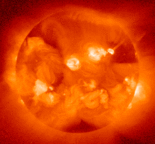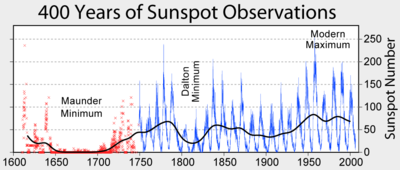- Maunder Minimum
-
The Maunder Minimum (also known as the prolonged sunspot minimum) is the name used for the period roughly spanning 1645 to 1715 when sunspots became exceedingly rare, as noted by solar observers of the time.
The concept became notable after John A. Eddy published a landmark 1976 paper in Science titled "The Maunder Minimum".[1] Astronomers before Eddy had also named the period after the solar astronomer Edward W. Maunder (1851–1928) who studied how sunspot latitudes changed with time.[2] The periods he examined included the second half of the 17th century. Edward Maunder published two papers in 1890 and 1894, and he cited earlier papers written by Gustav Spörer.
Like the Dalton Minimum and Spörer Minimum, the Maunder Minimum coincided with a period of lower-than-average global temperatures.
During one 30-year period within the Maunder Minimum, astronomers observed only about 50 sunspots, as opposed to a more typical 40,000-50,000 spots in modern times.[citation needed]
Contents
Sunspot observations
The Maunder Minimum occurred between 1645 and 1715 when very few sunspots were observed. This was not due to a lack of observations; during the 17th century, Giovanni Domenico Cassini carried out a systematic program of solar observations at the Observatoire de Paris, thanks to the astronomers Jean Picard and Philippe de La Hire. Johannes Hevelius also performed observations on his own. The total numbers of sunspots (but not Wolf numbers) in different years were as follows:
Year Sunspots 1610 9 1620 6 1630 9 1640 0 1650 3 1660 Some sunspots reported by Jan Heweliusz in "Machina Coelestis" 1670 0 1680 1 huge sunspot observed by Giovanni Domenico Cassini During the Maunder Minimum enough sunspots were sighted so that 11-year cycles could be extrapolated from the count. The maxima occurred in 1676, 1684, 1695, 1705 and 1716.
The sunspot activity was then concentrated in the southern hemisphere of the Sun, except for the last cycle when the sunspots appeared in the northern hemisphere, too.
According to Spörer's law, at the start of a cycle, spots appear at ever lower latitudes until they average at about lat. 15° at solar maximum. The average then continues to drift lower to about 7° and after that, while spots of the old cycle fade, new cycle spots start appearing again at high latitudes.
The visibility of these spots is also affected by the velocity of the sun's rotation at various latitudes:
Solar latitude Rotation period
(days)0° 24.7 35° 26.7 40° 28.0 75° 33.0 Visibility is somewhat affected by observations being done from the ecliptic. The ecliptic is inclined 7° from the plane of the Sun's equator (latitude 0°).
Little Ice Age
The Maunder Minimum coincided with the middle — and coldest part — of the Little Ice Age, during which Europe and North America were subjected to bitterly cold winters. A causal connection between low sunspot activity and cold winters has recently been made using data from the from NASA's Solar Radiation and Climate Experiment which shows that solar UV output is more variable over the course of the solar cycle than scientists had previously thought, and a UK scientific team published in the Nature Geoscience journal a link that ties this variability to terrestrial climate impacts in the form of warmer winters in some places and colder winters in others.[3] The winter of 1708–9 was extremely cold.[4]
Other observations
Some scientists hypothesize that the dense wood used in Stradivarius instruments was caused by slow tree growth during the cooler period. Instrument maker Antonio Stradivari was born a year before the start of the Maunder Minimum.[5]
Past solar activity may be recorded by various proxies including carbon-14 and beryllium-10.[6] These indicate lower solar activity during the Maunder Minimum. The scale of changes resulting in the production of carbon-14 in one cycle is small (about 1 percent of medium abundance) and can be taken into account when radiocarbon dating is used to determine the age of archaeological artifacts.
Other historical sunspot minima have been detected either directly or by the analysis of carbon-14 in tree rings; these include the Spörer Minimum (1450–1540), and less markedly the Dalton Minimum (1790–1820). In total there seem to have been 18 periods of sunspot minima in the last 8,000 years, and studies indicate that the sun currently spends up to a quarter of its time in these minima.
One recently published paper, based on an analysis of a Flamsteed drawing, suggests that the Sun's rotation slowed in the deep Maunder minimum (1684).[7]
During the Maunder Minimum auroras had been observed normally. Detailed analysis has been published by Wilfried Schröder[8] and J. P. Legrand et al.[9]
The fundamental papers on the Maunder minimum (Eddy, Legrand, Gleissberg, Schröder, Landsberg et al.) have been published in Case studies on the Spörer, Maunder and Dalton Minima.[10]
Trivia
- Curiously, the duration of the Maunder Minimum (1645–1715) coincides very closely with the reign of King Louis XIV of France (1643–1715), known as the Sun King.
See also
- Global Warming
- Spörer Minimum
- Solar minimum
- John A. Eddy, the astronomer who popularised the Maunder Minimum
References
- ^ Eddy J.A. (June 1976). "The Maunder Minimum". Science 192 (4245): 1189–202. Bibcode 1976Sci...192.1189E. doi:10.1126/science.192.4245.1189. PMID 17771739. http://www.sciencemag.org/cgi/content/citation/192/4245/1189. PDF Copy
- ^ Who named the Maunder Minimum?
- ^ "Solar forcing of winter climate variability in the Northern Hemisphere" (Press release). Nature Geosciences. October 9, 2011. http://www.nature.com/ngeo/journal/vaop/ncurrent/full/ngeo1282.html. Retrieved 19 October 2011.
- ^ Niles' Weekly Register, Volume 15, Supplement, History of the Weather
- ^ Whitehouse, David (December 17, 2003). "Stradivarius 'sound' due to Sun". BBC News. http://news.bbc.co.uk/2/hi/science/nature/3323259.stm. Retrieved 2009-05-12.
- ^ Field et al. (2009) (PDF). Giss. Nasa. http://pubs.giss.nasa.gov/docs/2009/2009_Field_etal.pdf
- ^ Vaquero JM, Sánchez-Bajo F, Gallego MC (2002). "A Measure of the Solar Rotation During the Maunder Minimum". Solar Physics 207 (2): 219. doi:10.1023/A:1016262813525.
- ^ Schröder, Wilfried (1992). "On the existence of the 11-year cycle in solar and auroral activity before and during the so-called Maunder Minimum". Journal of Geomagnetism and Geoelectricity 44 (2): 119–28. doi:10.5636/jgg.44.119. ISSN 00221392.
- ^ Legrand, JP; Le Goff, M; Mazaudier, C; Schröder, W (1992). "Solar and auroral activities during the seventeenth century". Acta Geophysics and Geodetica Hungarica 27 (2–4): 251–282.
- ^ Schröder, Wilfried (2005). Case studies on the Spörer, Maunder, and Dalton minima. Beiträge zur Geschichte der Geophysik und Kosmischen Physik. 6. Potsdam: AKGGP, Science Edition.
Further reading
- Luterbach, J. et al. (2001). "The Late Maunder Minimum (1675-1715) - A Key Period for Studying Decadal Scale Climatic Change in Europe". Climatic Change 49 (4): 441–462. doi:10.1023/A:1010667524422.
- Willie Wei-Hock Soon; Yaskell, Steven H. (2003). The Maunder minimum and the variable sun-earth connection. River Edge, NJ: World Scientific. pp. 278. ISBN 9812382755.
- What's wrong with the sun? (Nothing)
The Sun Internal structure 
Atmosphere - Transition region
- Coronal hole
- Coronal loop
- Coronal mass ejection
- Prominence
- Helmet streamer
Variation Heliosphere Related topics Categories:- Climate history
- Solar phenomena
Wikimedia Foundation. 2010.



